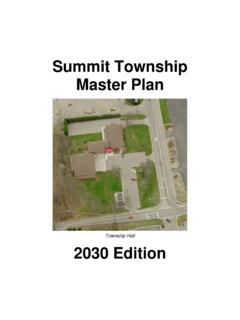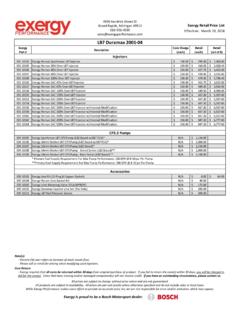Transcription of MICHIGAN RESIDENTIAL CODE 2003 - …
1 MICHIGAN RESIDENTIAL code 2003 . APPLICABILITY: A permit is required to construct, enlarge, alter, repair, move, demolish or change the occupancy of any structure. EXCEPTION: One story detached accessory structures if the floor area does not exceed 200 square feet. A. WHEN CAN I START: After issue of the Soil and Erosion Permit and the Land Use Permit clearing, grading, excavating, and forming may commence. Prior to concrete or in the case of a wood foundation, pea gravel being placed, a Building Permit is required to be in hand and posted on the job site.
2 (Public Act 230, Section ). B. PLAN REVIEW: The purpose of the Plan Review is to ensure the proposed construction meets code requirements prior to actual construction. Construction documents shall be of sufficient clarity to indicate the location, nature and extent of the work proposed and show in detail that it will conform to the provisions of this code and relevant laws, ordinance, rules, and regulations, as determined by the building official. This includes indicating the size, description, and locations for all structural members.
3 Also to be indicated on the plans is compliance with each item on this review sheet that is marked with a box. As a part of the construction documents submittal, site plans showing the size and location of new construction and any existing structures on the site and distances from lot lines shall be submitted. In complete plan submittals shall be returned to the applicant for revision. The building permit fee is based on one plan review, additional plan review time will be charged per the approved fee schedule. ( , ).
4 C. CALLING FOR INSPECTIONS: It is the permit holder's responsibility to notify the building department, with 24 HOURS NOTICE, for an inspection. Normally, there are 5 required inspections and approval is necessary for: (1) FOOTING, prior to placing concrete; (2). BACKFILL; before earth is placed, after drain tile, stone and damp proofing is installed; (3). ROUGH FRAMING AND MASONRY INSPECTION, after all required electrical, plumbing, and/or mechanical rough inspections have been performed, and prior to insulation, masonry inspections shall be made before the installation of masonry veneer and after the installation of base course flashing as specified in Section and weather resistant sheathing paper as specified in Section ; (4) INSULATION ; and (5) FINAL, prior to occupancy of the building structure.
5 If a reinspection is necessary, it is the permit holder's responsibility to notify the construction code office when the construction is ready for the reinspection. A reinspection is required when construction is not ready for inspection, or when the construction fails to pass an inspection. THIS WILL COST THE PERMIT HOLDER A REINSPECTION FEE. D. CERTIFICAT OF USE AND OCCUPANCY: A BUILDING/STRUCTURE MUST NOT. BE OCCUPIED UNITL A FINAL INSPECTION HAS BEEN PASSED AND A. CERTIFICATE OF USE AND OCCUPANCY HAS BEE ISSUED. Approvals from the building, plumbing, electrical, mechanical and soil and erosion (if required) inspectors must be obtained before occupancy can occur.
6 OCCUPANCY OF A BUILDING/STRUCTURE. WITHOUT A CERTIFICATE OF USE AND OCCUPANCY IS A VIOLATION OF THE. LAW. (SECTION 13 PUBLIC ACT 230 OF 1972, AS AMENDED). E. TEMPORARY CERTIFICATE OF USE AND OCCUPANCY: The building official is authorized to issue a Temporary Certificate of Occupancy before completion of the entire work covered by the building permit, provided that such portion or portions shall be occupied safely. The building official shall set a time period during which the temporary occupancy shall be valid. All safety requirements of the code are to be completed, such as, but not limited to: Handrails, guardrails, smoke detectors, egress requirements, fire, doors, and fire separation walls, firestopping, and final or temporary approvals from the plumbing, electrical & mechanical inspectors prior to the temporary occupancy permit being issued.
7 ( ). 1. F. PLEASE POST THE JOB WEATHER CARD (BUILDING PERMIT) IN A. CONSPICUOUS PLACE, VISIBLE TO THE INSPECTORS. GROUND SNOW LOAD = 25 LBS. PER SQ. FT. WIND SPEED = 90 MPH. SEISMIC CATEGORY = C. WEATHERING SEVERE. ASSUMED SOIL BEARING CAPACITY = 2000 LBS. IN SAND, 1500 LBS. IN CLAY. FLOOR LOADS: 40 PSF NON-SLEEPING AND 40 PSF DECKS AND 50 PSF GARAGE. FLOORS. CHAPTER 4 FOUNDATIONS. FOR WOOD FOUNDATIONS SEE WOOD FOUNDATION BOOKLET. FOUNDATION SYSTEMS shall extend below the frost line 42 . EXCEPTION: The footings in detached accessory structures not exceeding 400 sq.
8 Ft. in area or 10 feet in height shall extend 12 below grade to undisturbed soil. All vegetation and topsoil shall be removed for accessory structures. THE MIN. WIDTH OF CONCRETE FOOTINGS based on 2000 PSF soils (sand): 1. story = 12 , 2 story = 12 , and 3 story = 17 . The min. width of concrete footings based on 1500. PSF soils (clay): 1 story = 12 , 2 story = 15 and 3 story = 23 . SPREAD FOOTINGS shall be a min. of 6 in thickness. Footing projections shall be a min. of 2 and not exceed the thickness of the footing.
9 MIN. CONCRETE STRENGTH; Basement walls, foundations and other concrete not exposed to the weather. Basement slabs and interior slabs on grade, except garage floor slabs = 2500 PSI at 28. days. (a). Basement walls, foundation walls, exterior walls and other vertical concrete work exposed to the weather =. 3000 PSI at 28 days. (a). Porches, carport slabs and steps exposed to the weather, and garage floor slabs = 3500 PSI at 28 days. (b). (a) Concrete in these locations that may be subject to freezing and thawing during construction shall be air entrained concrete in accordance with (b) below.
10 (b) Concrete shall be air entrained. Total air content (percent by volume of concrete) shall not be less than 5% or more than 7%. DRAINAGE the grade away from foundation walls shall fall a min. of 6 within the first 10'. EXCEPTION: Where lot lines, walls slopes or other physical barriers prohibit 6 of fall within 10', drains or swales shall be provided to ensure drainage away from the structure. SOILS TESTING in areas likely to have expansive, compressible, shifting or other unknown soil characteristics the building official shall require soil tests to determine the soils' characteristics at a particular location.



